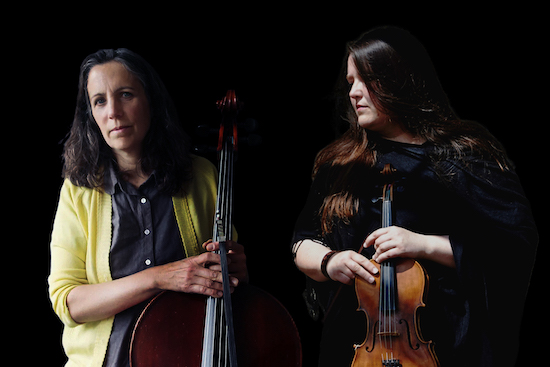We often read, don’t we, of music that defies genre definition. But it’s rarely the case that music is quite that hard to describe. Here, though, while I think I can describe at least some of its origins, is a record that might truly exist quite comfortably between idioms. Cellist Lori Goldston and multi-instrumentalist Laura Cannell combine their mutual distaste for the fixed tropes of genre, and in bringing each other’s approaches together find an idiosyncratic betweenness that is frankly bewitching.
There is within this music fleeting elements of the medieval, of traditional music, of chamber music, of contemporary classical, of free improv and maybe even the principles of post-rock in a glorious weave of reverberant tapestry, but it is never wholly any of these things. It is not perhaps the harmonic properties or challenging dissonance or indeed any notionally ‘musical’ signifiers that determine this outlier place, but the physical relationship each musician has with their instruments. There is something so vibrant, haptic and personal about each player that the result is almost preternatural. This might seem hyperbolic, but it’s a description I’m sticking with. It is not unique to just these two, but there is something wonderful about being able to access the feeling of pressure of a bow, or to wince slightly at the attack of a plucked string. Even to feel the wetness of breath. Acoustic instruments contain these things by default, but it is a great musician who can bring them so richly to the foreground.
I’ll admit that I have a particular interest in music of place, and in recordings made in churches. The fact that this record is both immediately skews my response firmly in their favour, though they are easy things to get wrong, perhaps by having too strict a methodology of the use of these features. The music was recorded at St Andrew’s in Raveningham and what remains of St Olave’s priory, both in Norfolk. There is, I fancy, some perhaps unconscious element of sacred music here. The same response to acoustic environment that one might find in the core of those awe-inspiring Renaissance masses. Not in the sense of rich polyphony per se, but in the sustained articulation of interval in space. Consider the opening track ‘Vaulted Echoes’, where brittle harmonics give way to overbowed, drawn-out fifths into which dissonance flirts, dance-like with the imposition of major thirds. It’s very beautiful, and utterly at home in the rich acoustic space of the stone. I would think it hard not to be informed by the architecture at play here.
The use of the voice in ‘Devil White Flowers’ lingers within the reverb, spilling out the texts of eighteenth-century East Anglian folk sayings. These texts also formed musical prompts and graphic score for the piece. It’s interesting that the cello is privileged over the voice here, forcing a particular focus to try to catch the words over the meandering, shape shifting pizzicato. It is, as the whole album is, a sort of exercise in the uncanny, where moments of sharp focus vanish into a gauze of grained uncertainty.
The beginnings of each track feel briefly like they might become some kind of recognisable version of folk, or chamber music, but every time recognition is snatched away as the music delivers something altogether different from what it might have been. ‘The Summer Tundra’ is great example of this. Beginning almost like a horror-folk fiddle tune and swerving quickly to a virulent experimentalism and freeform composition that is both highly appropriate to itself and wonderfully surprising. As such, there is (and I use these words very carefully) an unshakable authenticity to the music. I am completely convinced that only these two could have made this.
In trying to work out what I really mean by this, I’ve concluded that the key lies in timbre, both of the embodied signature of musicianship, and of the semiotically inscribed spaces themselves. The sepulchral ‘Lying Beneath the Earth’ might support this line of thought. Paradoxically spacious and claustrophobic, it is carried by gesture, the notes fairly dragged almost unwillingly out of the resonant wood. Video artist and musician Seamus Harahan has described acoustic instruments as ‘prosperous trees’, which I find an infectious sentiment, and how lucky the trees that became the means of sounding the ideas of this duo.
From the glorious flourishes of ‘The Underground Passage to the Castle’ to the deep creaking textures of ‘Below the Lowlands’, all frequencies and articulations are explored across the album. This is a timbral masterpiece of sensitivity, musical form, and the joy of sound in space. Unique, transhistorical, and genuinely enriching. One of the best things I’ve heard in some time.


